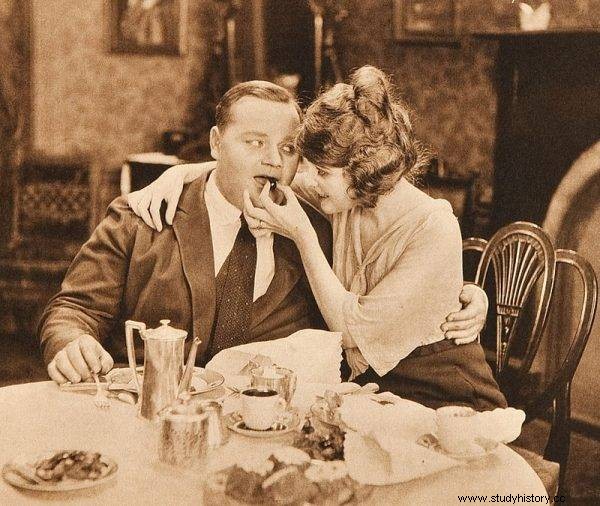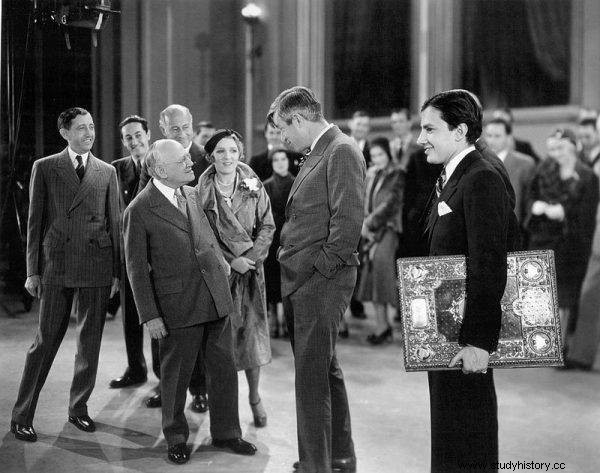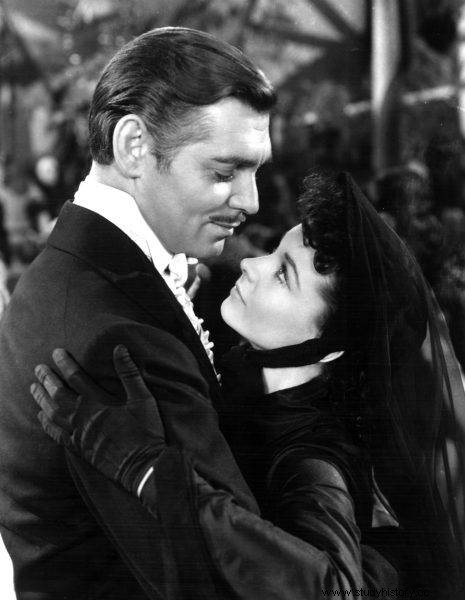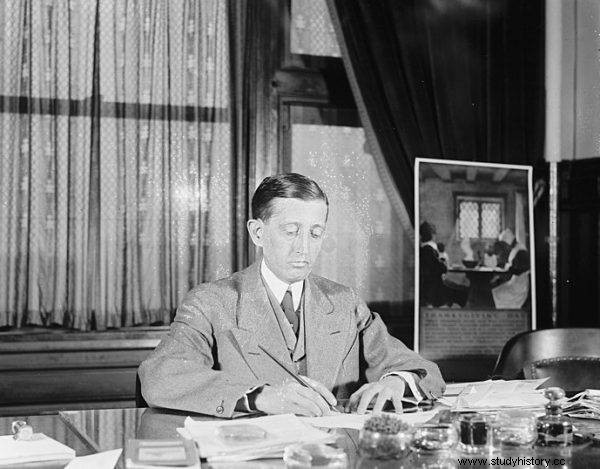In the 1930s, the "golden years" of Hollywood began. At that time, over 400 films were produced annually, and the cinemas attracted 90 million viewers a week. It was then that the most popular film genres took shape:westerns, slapstick comedies, musicals and noir companies. American cinema, however, flourished under the watchful eye of strict censors who dutifully blocked content deemed vulgar or scandalous.
The 1920s were a period of great development in American cinematography. The tenth muse had already gained immense popularity in the United States, but the second decade of the twentieth century was very important to Hollywood history. We are talking not only about the first sound films, but also about the fact that it was then, in the famous Los Angeles district, that the system of five studios was created, which eventually dominated the film market not only in the US, but all over the world.
The Big Five included Fox (today as 20th Century Fox), Loew's Incorporated (today Metro-Goldwyn-Mayer), Paramount Pictures, RKO and Warner Bros. In addition to these giants, there were other companies operating in Hollywood called the "little three", which included Universal Studio, Columbia Pictures and United Artists.
The main difference between them was the fact that the "big five" had private cinemas and their own actors, of which, of course, she tried to make big screen stars . The studio system in American cinema thus led to an increasingly distinct promotion of actors. Studios began to hire PR specialists, as well as "feed" the audience with curiosities and scandals from the lives of stars. Hollywood, however, did not miss the real big scandals that had a significant impact on the nature of the films produced in the "golden age".
Who was scandalized by Hollywood cinema?
In the 1920s, American society succumbed to a fascination with movies and their actresses and actors. However, this phenomenon led not only to an increase in the number of supporters of cinema, but also its opponents. Many Americans did not like the fact that movie audiences watched gangsters, "speakeasy" (secret bars selling alcohol during Prohibition) and liberated women who did not fit into the role of model housewives.
What's more, such stars as Rudolph Valentino or Pola Negri have increasingly become the object of erotic dreams of lovers of the new art form . The fire was fueled by scandals related to Hollywood stars.

photo:Famous Players-Lasky Corp./Paramount Pictures / public domain The case of Roscoe Arbuckle, the popular "Fat Girl" from the films with Charlie Chaplin, was very famous. The actor was charged with the rape and murder of actress Virginia Rappe
Among them, the most agitated was the murder of actor William Desmond Taylor and the famous case of Roscoe Arbuckle, the popular "Fat Girl" from the films with Charlie Chaplin. The actor was charged with the rape and murder of actress Virginia Rappe. Even though he was acquitted, the scandal destroyed his film career and he could no longer appear in front of the camera.
To improve Hollywood's social image, the Motion Picture Producers and Distributors of America (MPPDA) was founded in 1922. The leader of the organization that was to improve the image of Hollywood in the eyes of the public and control the content presented in it was the politician William Hays. In 1924, developed a set of rules for filmmakers that specified which topics should not be addressed .
Hays also instructed American studios to submit summaries of all their films to the MPPDA for approval by the committee. Mostly, however, film producers did not follow the politician's recommendations. This is evidenced by the fact that by 1929 only 20% of the film scripts were placed on Hays' desk before production. The decisive issue was still played by the local censorship commissions, which decided to introduce a given production to cinema screens.
Hays Code
Censorship in American cinema was not a new phenomenon in the 1920s. It actually existed since 1900. Responsible for it, however, were local and state censorship commissions, which decided about the productions broadcast in cinemas.
The problem for the producers was the lack of clear rules defining what content can be presented in films and what should not be included in them. When the first sound films appeared on posters, the problem of censorship even deepened . In addition to watching harmful content, viewers were also exposed to indecent sounds and vulgar words.

As a result, the Hays Code was developed, which clearly defined what content could not be used by Hollywood producers.
As a result, the Hays Code was developed, which clearly specified what content could not be used by Hollywood producers. Until 1954, the film censor Joseph Breen was responsible for its enforcement. The document became final in 1934 and marked the direction in which American cinema followed for almost the next 30 years.
Banned scenes index
Due to the code, film producers in the United States were not allowed to present in their productions activities deemed offensive by MPPDA. The document clearly and in detail defined topics that should be avoided at all costs. The following areas were audited:
1. Breaking the law: The code forbade filmmakers to depict detailed scenes of murders, burglaries, assaults and arsons from the films. It was absolutely forbidden to portray drug trafficking and alcohol-consuming heroes (unless absolutely necessary for the story).
2. Sexuality: The guidelines for portraying sex scenes on the screen were the strictest in American cinema. Among other things, the filmmakers were not allowed to portray adultery, "too much passion", seduction, rape, sexual perversion, and venereal diseases and childbirth. It was also forbidden to show relationships of couples with different skin colors and non-heteronormative ones.
3. Vulgar behavior: That would offend the audience were not tolerated.
4. Obscene words, gestures, jokes and songs: They couldn't spill out of the screen onto the "innocent" recipient.

However, filmmakers sometimes managed to beat the strict rules imposed by the Hays Code. The famous words of Clark Gable from the movie "Gone with the Wind" (1939) "Frankly, my dear, I don’t give a damn" have gone down in history
5. Dance: It was also inspected. It shouldn't be too passionate and sexual.
6. Unjustified blasphemy: Shouldn't be in American movies.
7. Costumes: The Code forbade showing nudity in films. The dancers' costumes, however, could not be too skimpy.
8. Religiousness: Hollywood movies could not offend or ridicule religious feelings. If a director wanted to feature religious ceremonies in his production, he had to do it respectfully.
9. National feelings: According to the code, national flags should be displayed on the screen with respect. The same was true of the history of nations and of important people from history.
10. Movie titles: They couldn't be vulgar and obscene.
11. Repulsive topics: The document also enumerated subjects that were allowed to be shown in the films, but to a limited extent. There were such themes as:the death penalty, brutal interrogations, brutality and rudeness, stigmatization of people and animals, violence against children and animals, and surgical operations.
However, filmmakers sometimes managed to beat the strict rules imposed by the Hays Code. The famous words of Clark Gable from the movie "Gone with the Wind" (1939) "Frankly, my dear, I don’t give a damn" have gone down in history which in the Polish version are known as "Honestly, my dear, I don't care." Producer David O. Selznick has had a long struggle to get them into the script. Eventually, Breen was persuaded and the word "damn" was spoken by the cinematic Rhett Butler.
A hero or an enemy of the filmmakers?
How do you evaluate the activities of William Hays? We commonly associate censorship with a political mechanism of blocking content inconvenient from the point of view of the authorities. In the case of American cinematography, however, it was quite different.
The Hays Code was not imposed on film companies by the authorities, but was rather a system of internal control. The context at that time should also be taken into account. A significant portion of American society identified the Hollywood community with moral corruption . She had a similar opinion about the films produced there.
The establishment of the MPPDA was aimed at improving the image and convincing the cinematography of its fierce opponents. There were organizations in the United States, such as the Legion of Decency, which called for a boycott of immoral films. The dominant studios had to adapt to social requirements in order for the film business to bring as much income as possible.

William Hays received his own star on the Hollywood Walk of Fame.
The Hays Code ceased to apply in the 1960s. This was due to moral changes and the growing popularity of European cinema, unfettered by such rigid rules. Certainly, strict rules severely limited the filmmakers' creativity. On the other hand, it was during its period that Hollywood experienced its "golden years". Probably cinema would not have achieved such popularity in the USA if American cinema remained the enemy of the then "defenders of morality" . Perhaps for this reason William Hays received his own star on Hollywood Walk of Fame.
Established in the 1920s, the MPDDA still exists, but today it mainly deals with giving age restrictions to film productions and fighting piracy. There is also no Hays Code that would impose the shape of films on producers. Although in this case the opinions are divided. Last year, Tomasz Raczek stated, for example, that the new Oscars were so heavily dominated by political correctness that producers received a new Hays Code.
Bibliography:
- Misiak, Controlled cinematograph , Universitas Publishing House, Krakow 2006.
- D. Black, Hollywood Censored:Morality Codes, Catholics, and the Movies , Cambridge University Press, Cambridge 1994.
- Szymkowska-Bartyzel, Political correctness in American cinema:a compromise or a compromise? , in: American Democracy in the 21st Century , ed. A. Mania, P. Laidler, Publishing House of the Jagiellonian University, Krakow 2006.
- Lubelski, Cinema Encyclopedia , Wydawnictwo Biały Kruk, Krakow 2010.
